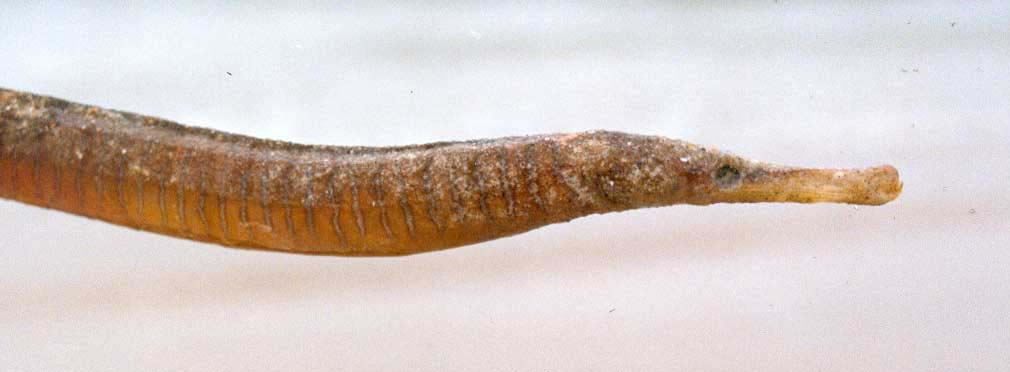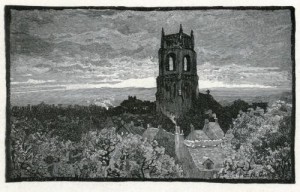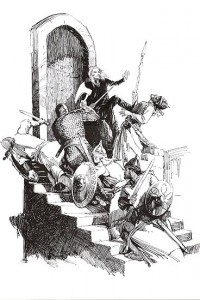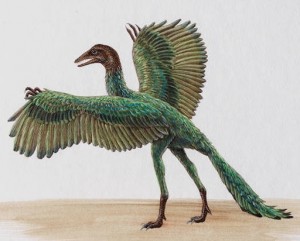Alternate Lanterns
 We’re bringing you some campaign flavor this Halloween night, in the form of alternate lanterns to light up the night.
We’re bringing you some campaign flavor this Halloween night, in the form of alternate lanterns to light up the night.
Hollowed Vegetables
Citizens of towns and villages carve out the centers of excess vegetables from the harvest, placing them on their doorsteps to light the paths. Commonly carved vegetables include pumpkins, potatoes, and turnips, which, when carved, are called jack o’lanterns, named after the phenomenon of strange light flickering over peat bogs, called ignis fatuus.
Hammered Tins
Tins will often have holes pressed through them to allow light through. These are filled with candles and set out as long-term light sources with short-term fires.
Wooden Barrels
Some townsfolk are fond of chiseling or sawing holes in wooden barrels set at intersections, wherein smaller lamps are often placed. These holes allow light to pass through, illuminating the path, while protecting the wick from wind and rain.
Posted in Uncategorized and tagged campaign flavor by Stephen Hilderbrand with no comments yet.
A Series of False Trap Sketches
Inspired by a brief conversation from tonight’s role playing session, here are some false trap ideas for your dungeons. They’re brief themselves; so be it.
Alternate Flooring
One way to keep your party (especially the rogues) on their toes is to mix up the flooring. Drop in fitted stone where there is mostly naturally-hewn rock, or parquet in the middle of a wealthy treasure chamber. These false positives will set the party up to let their guard down for the real traps awaiting them!
Spurious Tripwires
Have tripwires in dungeons that don’t set off any traps. These wires might set certain levers, building to a larger trap, be lines to traps already set off, or simply be duds, traps that never seem to work.
False Pits
Have floors drop out from under the party, only to have them land 6″ below the normal floor. This will set them at ease… Or will it!?!?
Anti-trap Tripwires
Have these tripwires drop shields that protect the party from the falling rocks in the next room, or provide other potential escapes and work-arounds, such as opening up a side chamber or otherwise revealing a potential escape.
Posted in Trap and tagged dm tips by Stephen Hilderbrand with no comments yet.
Giant Pipefish
 Slithering out from the the reef, a giant eel of a beast swims toward you.
Slithering out from the the reef, a giant eel of a beast swims toward you.
Giant Pipefish
Size/Type: Large Animal (Aquatic)
Hit Dice: 12d8+46 (107 hp)
Initiative: +8
Speed: Swim 90 ft. (12 squares)
Armor Class: 27 (-1 size, +6 Dex, +12 natural)
Base Attack/Grapple: +10/+23
Attack: Bite +17 melee (2d6+5)
Full Attack: Bite +17 melee (2d6+5)
Space/Reach: 10 ft./10 ft.
Special Attacks: Improved grab, constrict
Special Qualities: Keen scent
Saves: Fort +10, Ref +15, Will +8
Abilities: Str 21, Dex 23, Con 15, Int 1, Wis 12, Cha 10
Skills: Listen +14, Spot +10, Swim +24
Feats: Improved Natural Attack (bite), Weapon Focus (bite)
Environment: Cold aquatic
Organization: Solitary or pair
Challenge Rating: 10
Treasure: None
Alignment: Always neutral
Advancement: 13-18 (Huge); 19-32 (Gargantuan)
Level Adjustment: —
Giant pipefish attack anything they perceive to be edible, even larger creatures, constricting them until they stop breathing.
This monstrous fish can grow to a length of 25 feet and weigh more than 4,000 pounds.
Combat
Giant pipefish entangle their foes in their long, tentacle-like bodies.
Improved Grab (Ex): To use this ability, a dire shark must hit with its bite attack. It can then attempt to start a grapple as a free action without provoking an attack of opportunity. If it wins the grapple check, it establishes a hold and can try to swallow the foe in the following round.
Constrict (Ex): A creature with this special attack can crush an opponent, dealing bludgeoning damage, after making a successful grapple check. The amount of damage is given in the creature’s entry. If the creature also has the improved grab ability it deals constriction damage in addition to damage dealt by the weapon used to grab.
Keen Scent (Ex): A giant pipefish can notice creatures by scent in a 180-foot radius and can detect blood in the water at a range of up to 1 mile.
Skills
A giant pipefish has a +12 racial bonus on any Swim check to perform some special action or avoid a hazard. It can always choose to take 10 on a Swim check, even if distracted or endangered, and get a free tumble check to move through opponents spaces, avoiding attacks of opportunity.
It can use the run action while swimming, provided it swims in a straight line.
Posted in 3rd edition Dungeons & Dragons / d20 fantasy / Pathfinder, Creature and tagged animal by Stephen Hilderbrand with no comments yet.
Proppian Player’s Guide (Oct 20 DRAFT)
 Here is the next installment of the Proppian Player’s Guide.
Here is the next installment of the Proppian Player’s Guide.
Spending the last two weeks in a cabin in the Finger Lakes has continued to inspire the development of the guide, as has The Oxford Illustrated History of Medieval Europe and a few fairy tales I’ve had my head planted within. We’ve experienced autumn and winter in the same week, and it’s been memorable — lots of hauling wood and fire-stoking, interspersed with storytelling and lots of writing.
The result in this guide is more depth in the NPC classes, and at the request of some upcoming players to the realm, more information on the key nations of the region that they’ll begin in. These nations will be fleshed out in much more detail in the Proppian Storyteller’s Guide, since it’s information that shouldn’t be well known by the players, since the idea is to have them learn it in-game. However, to get my new players in the right frame of mind to create their characters, it helps to have some basis for their made up reality.
New NPC classes include:
Acrobat: Sneaking about the urban landscape under cover of darkness, the acrobat balances tight rope walking with weapon finesse to provide an athletic character class.
Friar: Traveling the world to preach their own interpretation of the gospel, friars know much of the world and contemplate the afterlife often. Others may see them as overly dogmatic, but they insist they are faithful to their faith, and this keeps them going as they journey from hamlet to township, making observations that they tie back to ancient parables in homilies delivered to all who will listen.
Hunter: Wandering the forest in search of food, hunters have learned where to aim, how to stand, and when to attack their prey. This makes them formidable foes in woods, cities, and dungeons, wherever they may roam.
Jongleur: The ballads sung by wandering minstrels don’t do their adventuring lives justice. In their long-winded tales, they tend to dance around the central theme as well as they dance rings around the local nobility and robber barons alike with their wordplay and wit.
Merchant: Nearly every society requires commerce to thrive, and who but merchants ensure that commerce is successful. Found in almost every settlement, merchants live for one of two things: to see the community prosper through their individual actions, or to see themselves prosper as the expenses of the community grow.
Scholar: Living physically sheltered lives in cloisters and monasteries, these true monks known as scholars receive exemplar educations. Others call them bookish, but when the need for ancient knowledge or other long-dead lore arises, they are often the only ones able to provide the proper perspective for the situation.
Shepherd: Astute animal handlers with aptitude for deep thinking and spending long periods of time in concentration, shepherds are known for their no-nonsense understanding of the ways of the world.
Tinker: Toiling away in their laboratories, tinkers develop new devices to solve society’s problems. Some of these improvements are seen on the battlefield, others in the healer’s tent, and still others remain in their labs, to one day be discovered by some courageous adventurer.
Get the latest version of the fairy-tale-oriented, Medieval guide here. Remember that this guide is still under development, to be released by the end of this year.
Posted in Uncategorized and tagged proppian by Stephen Hilderbrand with no comments yet.
Wild Arbors of Mahdihly Vale
Outlaws defied the local law, setting up a camp in the local baron’s private wood. On a sacred night for believers of the dominant religion in the area, the Baron Allain sent his men into the wood, attacking the outlaws while they were in prayer. The outlaw men were hanged from the trees overhead while their families watched. They wept and prayed out loud, finally shouting insults at the baron’s men.
One of the women shouted, “for many days have these men cared for your arbors! May these trees enact a tax on your bloodthirsty life!”. She was run through on the spot by the baron himself.
A week later, he passed through the scene of the crime on his way back from battle with a small retinue, including some of the men who carried out the hangings. The baron never made it home that night, nor did any of his men. When his castle guard returned to investigate, they noted that the roots of the trees had grown in a circular barrier and that the baron and his men’s bodies were found hacked to pieces in the corral, and there were no signs of his horses, nor the corpses of the outlaws that had been left to rot.
Posted in Uncategorized and tagged history, proppian, rumors by Stephen Hilderbrand with no comments yet.
Llana d’Arth
This woman of the sea would sun herself on rocks a good deal off the coast of the Jæruel for those few summer weeks when the clouds would part and the light stream in sharp contrast to the grey clouds in the distance.
One summer, she was caught in the nets of a fishing trawler, and dragged up on deck. The men were frightened by her until she spoke in their tongue, asking to be set free. They complied, and she thanked them and swam off, back to her rocks to sun. They returned to the rocks the next day and she was gone.
Later that season, she swam up to their vessel and warned them of an approaching storm. Turning back to shore, they returned in time to warn the rest of the town, which boarded up and weathered the storm with minimal damage.
The fishermen were branded heroes by their fellow citizens.
Rumor has it that fishermen still see her in those sunny summer weeks out there on the rocks.
Posted in Uncategorized and tagged history, Jæruel, rumors by Stephen Hilderbrand with no comments yet.
Sylvanthread Armor
This extremely light cloth armor is made of finely-woven sylvanthread. Speed while wearing sylvanthread is 40 feet for medium creatures, or 30 feet for small. The armor has an arcane spell failure chance of 5%, a maximum Dexterity bonus of +6 and no armor check penalty. It is considered extra-light armor and weighs 5 pounds.
Sylvanthread armor provides a +4 AC bonus.
No aura (nonmagical); Price 3,250 gp.
Posted in Uncategorized and tagged armor, masterwork, sylvan by Stephen Hilderbrand with no comments yet.
Holy Caltrops
Holy caltrops are runes the wielder drops on the ground to slow and damage the undead. The runes have a single activation keyword, the name of the rune. The runes deal 2d8 holy damage to and slow any undead in a 20′ radius which fail a DC 20 reflex save. Undead creatures which step on the caltrops must make a DC 25 reflex save or take 3d8 holy damage.
If laid as a trap, the caltrops do not require the keyword to activate them, but also do not affect all those in a 20′ radius; only those undead which step upon the caltrops are affected.
Greater holy caltrops raise the DC by 5 and the damage by a d8; lesser remove 5 DC and a d8.
Moderate enchantment. Must be blessed by a cleric of at least level 9. Price: 2,500 (lesser), 5,000 or 7,500 (greater) gp.
Posted in Magic Item, Trap and tagged holy by Stephen Hilderbrand with no comments yet.
Proppian Player’s Guide (Oct 1 DRAFT)
 Welcome to Proppia, a fantastic land of medieval fairy tales, where knights in plate armor occupy turreted castles of stone, where struggling merchants hawk exotic wares in the town squares, where an ordinary journey becomes a dangerous adventure, where priests claim miraculous powers, alchemists bent on affecting the world mix powerful concoctions, and where scholars study arcane tomes written in long-dead languages for the secrets to powerful incantations.
Welcome to Proppia, a fantastic land of medieval fairy tales, where knights in plate armor occupy turreted castles of stone, where struggling merchants hawk exotic wares in the town squares, where an ordinary journey becomes a dangerous adventure, where priests claim miraculous powers, alchemists bent on affecting the world mix powerful concoctions, and where scholars study arcane tomes written in long-dead languages for the secrets to powerful incantations.
Based on feudal medieval history, this world is chaotic and violent, and differs from traditional d20 worlds in that arcane and divine magic are hard for player characters to acquire and require intense in-game activity to wield. Without instant healing and three fireball spell slots a day to ward off the many bandits, the roads and rivers are unsafe, let alone the deep wilderness with its dark denizens. In the monarchies, republics, theocracies, and military states, bribery and corruption are as commonplace as poverty and superstition. The fears and superstitions that manifest in the songs of bards and the whispers in dark corners of taverns are likely true, though often embellished when shared with the intoxicated masses.
In this midst of this general disorganization, expansionist kingdoms send their armies to ravage the countryside, strange creatures infest underground mines, thieves stalk mountain passes, witches intone loathsome curses, and various cults deliver dogmatic sermons in forest clearings as they vie for the allegiances of the people. Aggressive animals and strange creatures have reported throughout the land, especially in the forests.
The world of Proppia is inspired by Europe between the 15th and 16th centuries, covering the end of the Dark Ages, the emergence of the Renaissance, and the folk tales captured by the Brothers Grimm and others. The new ideas of the Renaissance have begun to usher in a period of change to the world. The strange, miraculous and magical elements simply reflect popular beliefs, superstitions and myths. This is an era before formal logic or widely-accepted science, a time when anything is still possible in the minds of the people. In short, if medieval Europe believed something might be true, in Proppia it may actually be true. In fact, the players are responsible for and encouraged to bring the fantastic ideas from fairy tales to life within the world. This is, after all, your story; your place to game. Make it fun.
Over the course of the campaign, you will travel across many lands, meet diverse personalities, wage war, crawl from from the ashes of battle, and discover and wield new and ancient magics. You will explore many different city and nation states, castles, hamlets, monasteries, dungeons, and a dangerous, unforgiving landscape of moors, primeval forests, and deep caverns. You will encounter unique creatures as well as those traditionally found in fantasy role playing settings. You will trip over and unwillingly discover specially-designed traps.
There are many opportunities to perform heroic deeds that live forever in the minds of the people, and that fill your purse. If you travel far and wide and accomplish enough, you will be known among Sigfried, Beowulf, Roland, Frodo, and other heroes whose stories are still told today. You may even have your story told and retold by each new generation. One of the goals of Proppia is to generate enough story material for a series of medieval fairy-tale sagas.
And so you are invited to relax your notion of the rigid rules of the 3.5 (and 4th ed) systems and enter Proppia, a world where history and fantasy meld together in a low-magic, high-adventure campaign of politics, intrigue, and mystery. Tiptoe forward from the back of the tavern and take the stage as a lead character in Proppia, and prepare yourself for a lifetime of quests and heroic adventures…
Download a draft copy of the Proppian Player’s Guide. Note that it’s still in the works, but is coming along.
Posted in news, Sourcebook and tagged proppian by Stephen Hilderbrand with 1 comment.
